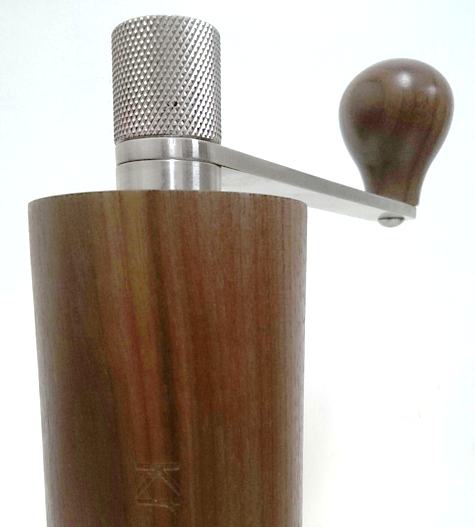Hausgrind Hand Powered Coffee Grinder

Best hand powered coffee grinder
Let’s cut right to the chase: You cannot find a better hand powered coffee grinder than the Made by Knock Hausgrind. Oh, we know the names of all the competitors – Porlex, Hario, Comandante, and even the Grindripper – but none of them are built like this.
Grinders come in two flavors: blade and burr. Blade grinders are fast, but they burn the coffee beans, and the uneven particle sizes they produce mean a poor cup of coffee. If you care what your coffee tastes like, burr grinders are really your only choice.
Among burr grinders, the camps are pretty evenly divided. Proponents of ceramic burrs will tell you they’re harder and last longer. Advocates of steel burrs will tell you they can be ground sharper and finer than ceramic burr casting technology allows. The Hausgrind uses 38 mm conical tool steel burrs that are conservatively rated to grind 650 kg (= 1433 pounds = ~3/4 of a ton) of coffee beans before needing replacement. I grind 15 grams of coffee beans every day, which is enough for a double shot of espresso from my ROK. That means I could go 43,333 days (= 118.72 years) before the burrs needed replacement. Even if you ground 3 times that much, you could go more than 39 years before you started to think about replacing your burr set.
Many people like to change up the coffee they drink, shifting from espresso to drip to French press at a whim. This means adjusting the setting on your grinder to change the fineness. On every other hand grinder out there, this involves twisting a knob on the bottom of the male burr to tighten or loosen it against the female burr. Often, this adjustment knob is stepped to prevent the loss of the setting as you grind. That means the settings are finite, and if you want something in between, you’re out of luck. With the Hausgrind, adjustment is performed with a graduated, knurled knob on the top of the grinder. The settings are smooth and infinite, held in position with a rubber grommet, and if you want to twist it to 9.6 (or 9.7 or 9.9) for your espresso and 13.2 for drip brewing, you can easily do so. Returning to a previous setting is also just as easy.
Some hand grinders have a problem with their handles coming off while grinding, and this is endemic with the Porlex. This is less of a problem with the Hario, Comandante, and Grindripper, but it is nonexistent with the Hausgrind – the adjustment knob screws on to completely secure the handle.
A lot of people complain that hand grinders are difficult to operate. Although this is largely due to the plastic bearings allowing the burrs to grind against each other, some of the blame can be traced to how the grinder is held. If the grasping hand is not at the very top of the grinder, the top of the grinder will swing back and forth as the handle is turned. The handle design is crucial to this, and some grinders actually come with a handle that forces the grasping hand lower on the grinder body. This is not so with the Hausgrind, whose handle allows the body to be grasped at the very top.
Because even the most freshly roasted coffee begins to stale 15 minutes after grinding, the home brewer gets the best flavor by grinding only what’s needed for the moment’s cup. That means you don’t want any leftover beans remaining in the grinder, so to keep things flowing smoothly, there is a sweep pin to ensure all the beans in the hopper drop into the burrs.
But none of these are the most important factor that set this grinder apart from the others. Whether you like the ceramic burrs of the Hario, Porlex, or Grindripper or you prefer the steel burrs of the Comandante, they all have one thing in common: plastic bearings. With all other hand grinders, the male burr depends from a central shaft that rotates within a plastic tube. Although the female burr is firmly held by the casing, the male burr can easily shift from center as the beans are ground. This doesn’t just cause wear; it creates an uneven grind.
In contrast, the Hausgrind has raced bearing sets top and bottom, and these bearings are held in place by 316 marine grade stainless steel frames. Together, they stabilize the burr sets to effortlessly produce a frighteningly even particle size.
Finally, we’re not talking about some visual monstrosity you wouldn’t show your dog. The Hausgrind currently comes in hand-tooled beech or walnut, and future versions are planned with aluminum and steel casings.
I was lucky to get in on the ground floor for Batch 1. Batch 2 sold out within 35 hours of announcement, and Batch 3 ordering is now closed. You can read more and register for yours here.
At £130 for aluminum and £140 for walnut (they’ll ship anywher), these grinders are not cheap. But they are simply the best, and they’ll likely last your lifetime or longer!
01/20/15Hausgrind Hand Powered Coffee Grinder £130 - £140






